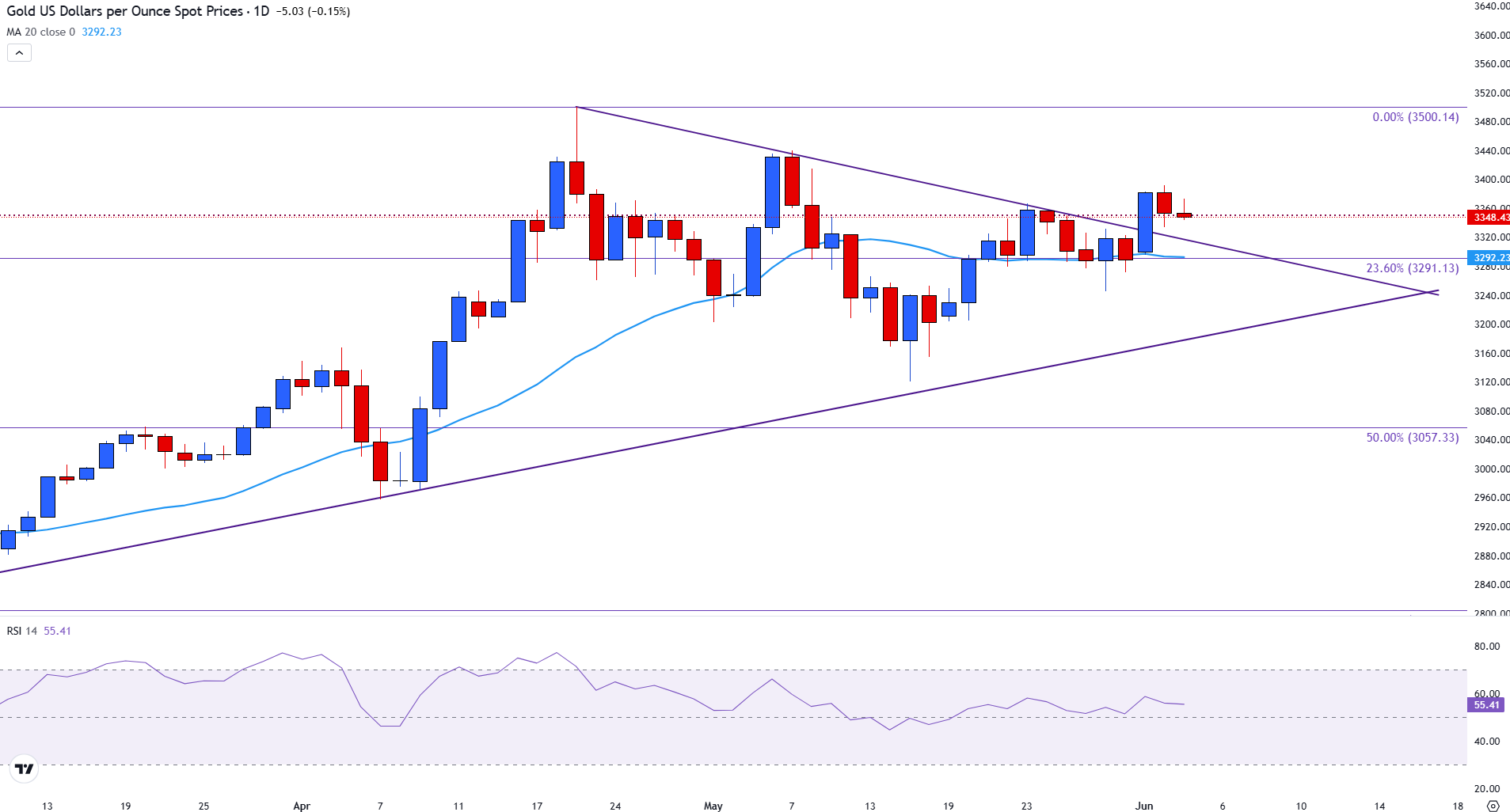Gold finds floor as US-China trade tensions resurface
- Gold strengthens slightly as US-China trade tensions resurface after Trump said China’s Xi is “extremely hard” to deal with.
- US ADP data is expected to provide insight into the resiliency of the private sector employment situation.
- Gold prices whipsaw as psychological support at $3,350 holds.
Gold trades broadly stable on Wednesday’s mid-European session, paring back some gains seen earlier in the day, driven by a weaker US Dollar (USD), as doubts over a US-China trade deal grow given recent comments from US President Donald Trump.
Trump said on Wednesday that it was “extremely hard” to make a trade deal with Chinese President Xi Jinping, CNBC reports. The comments arise as Washington has fuelled speculation that a call between the two leaders could happen this week.
“I like President XI of China, always have, and always will, but he is VERY TOUGH, AND EXTREMELY HARD TO MAKE A DEAL WITH!!!” Trump wrote on Truth Social.
Chinese Foreign Ministry spokesman, Lin Jian, replied, stating that “China’s principle and position of developing China-US relations is consistent,” Bloomberg reports. The comments suggest that China hasn’t changed its stance since meeting with US representatives last month.
Prospects of a weak trade deal with China, or even no deal, generally benefit safe-haven assets such as Gold.
US 50% tariffs on steel and aluminium are in force
With a 50% tariff rate now in place for aluminum and steel imports into the United States (US), trade relations between the US and its global counterparts remain strained. This provides an additional tailwind for Gold prices and a headwind for major risk assets.
Following positive trade talks between the United States (US) and China in mid-May, which helped ease tensions between the world's two largest economies, the negotiations appear to have stalled.
With both parties accusing each other of violating the agreement reached in Geneva on May 12, uncertainty surrounding trade relations remains a key driver of Gold prices.
However, Gold’s nemesis appears to be the interest-rate trajectory for global central banks, which are preparing to announce the next round of rate decisions this week. Since investors holding Gold bars or coins do not yield any returns from holding these assets, interest rates are seen as a threat, especially when banks offer higher rates.
On Wednesday, markets are expected to monitor the release of the ADP employment report from the US at 12:15 GMT for clues on how the private sector labor market performed in May. The report comes ahead of the US Nonfarm Payroll release on Friday, which is expected to provide additional insight into the resiliency of the US labour market.
Gold daily digest: China, tariffs, and employment data back in focus
- The Geneva deal had established a 90-day pause on escalating tariffs between China and the US, with the US reducing tariffs on Chinese goods from 145% to 30%, and China lowering tariffs from 125% to 10%. The agreement also included provisions for China to lift restrictions on the export of critical minerals essential to US industries.
- With the European Central Bank (ECB) gearing up for Thursday's interest rate decision, the release of the Purchasing Managers Index (PMI) throughout the morning has provided a mixed picture about the health of the manufacturing and services sectors throughout the Eurozone. The combination of clear signs of an economic slowdown and slowing inflation is perceived as a warning sign of a potential recession, with spending and demand for goods and services expected to fall.
- For the ECB, inflation data released Tuesday supported market expectations of an additional 25 basis points (bps) rate cut on Thursday.
- Although PMI data from Italy and France came in above estimates, Germany’s data continued to underperform, suggesting that business confidence and the country’s growth outlook remain gloomy. Since Germany is the largest economy in the Eurozone, diminishing growth forecasts place additional pressure on the ECB to provide support to the European economy by continuing to cut interest rates.
- As for the Fed, the CME FedWatch Tool continues to show a 55.6% probability of the US central bank announcing a rate cut in September. A downside surprise in the ADP number may provide temporary relief for Gold as it would increase the chances that the Fed cuts rates in July. For now, the probabilities of such moves aren’t significant.
Gold technical analysis: Prices remain conflicted near $3,350
Gold prices are trading in a consolidative phase above a symmetrical triangle on the daily chart, with the price hovering near $3,355.
Despite a temporary break above the triangle resistance on Monday, prices have failed to gain momentum above the current psychological support level of $3,350.
The 20-day Simple Moving Average (SMA), currently at $3,292, offers additional support.
A break below this level and the triangle base near $3,290 (aligned with the 23.6% Fibonacci retracement of the January-April rally) would expose the $3,057 support zone, marking the midpoint of the aforementioned move.
A deeper decline could extend to $2,804, the 78.6% Fibonacci retracement, if bearish pressure intensifies. The Relative Strength Index (RSI) at 55 supports a mildly bullish bias, but a clear directional move will depend on a breakout from the current range.
Gold daily chart

US-China Trade War FAQs
Generally speaking, a trade war is an economic conflict between two or more countries due to extreme protectionism on one end. It implies the creation of trade barriers, such as tariffs, which result in counter-barriers, escalating import costs, and hence the cost of living.
An economic conflict between the United States (US) and China began early in 2018, when President Donald Trump set trade barriers on China, claiming unfair commercial practices and intellectual property theft from the Asian giant. China took retaliatory action, imposing tariffs on multiple US goods, such as automobiles and soybeans. Tensions escalated until the two countries signed the US-China Phase One trade deal in January 2020. The agreement required structural reforms and other changes to China’s economic and trade regime and pretended to restore stability and trust between the two nations. However, the Coronavirus pandemic took the focus out of the conflict. Yet, it is worth mentioning that President Joe Biden, who took office after Trump, kept tariffs in place and even added some additional levies.
The return of Donald Trump to the White House as the 47th US President has sparked a fresh wave of tensions between the two countries. During the 2024 election campaign, Trump pledged to impose 60% tariffs on China once he returned to office, which he did on January 20, 2025. With Trump back, the US-China trade war is meant to resume where it was left, with tit-for-tat policies affecting the global economic landscape amid disruptions in global supply chains, resulting in a reduction in spending, particularly investment, and directly feeding into the Consumer Price Index inflation.

